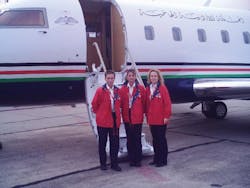The perpetual “First Impression”
Pullquote:
First impressions count. We make 11 major decisions about one another in the first 7 seconds of our first interaction.
--NYU
After a safe landing following a pleasant flight on a beautiful morning, an aircraft taxis into an FBO. But there is no one there. There is no one to marshal in the arriving aircraft, and with few other aircraft parked on the ramp, the flight crew is left to decide where to park on their own.
Suddenly a facility door flies open, and an individual struggling to don a safety vest hurriedly grabs a set of chocks and drags a red floor mat out to meet the “self parking” aircraft. As the cabin door opens and the “out-of-breath” line service technician fights to properly the place the floor mat, the crew and passengers begin to emerge. Suddenly another line service technician pulls up on a tug pulling an LAV cart and yells: “Hey, they need anything?”
Unfortunately, this is an all too common scenario. Even if this were a long-standing, well-established customer, every time line ops meet the customer, it is a “first impression” for that exchange. But let’s back up a little and see how we could improve this situation.
Communicate, Communicate, Communicate
In the above example, the scheduler and dispatcher for the flight department had called in two weeks prior informing the FBO of the requirements for the passengers, aircraft and flight crew.
That information should have been documented and shared in a “shift briefing.” FBO personnel should have followed the incoming aircraft’s flight; that aircraft was most certainly on some type of electronic tracking system, possibly for hours! The aircraft likely called in and reported “20 minutes” out and probably had a scanner tuned to ground control where the pilot would have been heard to say: “This is aircraft N123, we would like to taxi to XYZ FBO.” So why was it a surprise then when the customer showed up?
As the above example illustrates, it is critically important to plan flightline work as best as possible and communicate that plan to everyone concerned.
“Is it possible to over communicate?
Consider this: “Would you rather be told about customer requirements three times, or not at all?” The more that is known about a customer’s basic needs, wants and preferences, the better you can be of service.
Maintain a Servant’s Heart
It was once just a requirement for anyone working the flightline to be safe and know the basics of proper ramp operations. That too is different today. With reduced staff and increased profitability demands, it is critically important that individuals charged with meeting the aircraft, converse with passengers and coordinate with flight crews and fellow team members. These individuals must be ready, willing and able to be of service to others.
It is not about being anyone’s servant, however. It is about being a professional and assisting those without your expertise to help them navigate your employer’s operation with safety and ease.
FBOs should want their customer’s experience to be pleasant and maybe even memorable. No one will describe their experience as, “WOW, you will never believe the great fuel we received today!”, but they might say, “You will never believe the wonderful service we received today at XYZ FBO. We saw five FBOs over the course of three days of travel and what a different experience we had at there!”
Check Your Appearance and Attitude
A study by New York University researchers revealed we make 11 major decisions about one another in the first 7 seconds of our first interaction. This research shows that in business interactions, first impressions are absolutely crucial.
On the flightline, appearance can offer an at-a-glance view of the level of professionalism and the anticipated level of service that can be expected. As one taxis onto an FBO ramp, if the facility is in disarray, the employees look like they have been rolling around under a greasy fuel truck, equipment is dirty and in poor condition, and no one looks very happy to be there, that first impression is not a positive one. Once inside, if customers see that the person behind the front counter never picks up his/her head to make eye contact and greet them, they may feel their presence is an imposition.
SMILE! Let customers at least think that you are happy to see them and happy to be of service. Welcome the customers, ask them their names, share your name, and begin a relationship!
Be Professional
Line service technicians often lament, “Those pilots … they never pay attention to my hand signals!” But when they are observed marshaling, it looks like they are swatting flies or fanning themselves. No wonder pilots fail to follow their hand signals, they are either uninterruptable or indistinguishable!
Customers can quickly determine an FBO’s level of professionalism by what line service technicians are doing and how they are doing it. Sometimes simple things like just wearing PPE (Personal Protective Equipment), speaks volumes. If employees show they care about their own safety, it gives the impression that that they are also safe with aircraft.
Using proper equipment like wands or flags to marshal, direct and park aircraft, including both day wands and lighted wands at night, adds another level of professionalism. Driving equipment safely and professionally on the ramp, especially around aircraft, speaks volumes about an FBOs level of professionalism.
Each interaction with a customer provides an opportunity to make a positive and memorable first impression. If all tasks are performed proficiently and professionally, FBOs will find customers returning not just for fuel, but for the service they provide.
BIO: Walter Chartrand is a training instructor with Aviation Training Academy, a firm dedicated to the training and continued education of professional aviation ground support personnel. More information on the training Aviation Training Academy offers can be found at: www.aviationta.aero.
